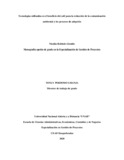Mostrar el registro sencillo del ítem
Tecnologías utilizadas en el beneficio del café para la reducción de la contaminación ambiental y los procesos de adopción
| dc.contributor.advisor | Cantillo Estrada, Carmen | |
| dc.coverage.spatial | cead_-_eje_cafetero | |
| dc.creator | Robledo Giraldo, Nicolás | |
| dc.date.accessioned | 2021-05-04T22:41:05Z | |
| dc.date.available | 2021-05-04T22:41:05Z | |
| dc.date.created | 2021-05-04 | |
| dc.identifier.uri | https://repository.unad.edu.co/handle/10596/40471 | |
| dc.description.abstract | El café colombiano tiene una alta demanda a nivel mundial por la calidad, esto obliga al sector cafetero a aumentar su productividad y competitividad. Estos desafíos traen adheridos impactos negativos al medio ambiente por la aplicación de tecnologías insostenibles, un ejemplo de ello es el proceso de beneficio convencional del café, el cual para su ejecución necesita grandes cantidades de agua, las cuales en el proceso de transformación generan subproductos como la pulpa y el mucilago que contienen grandes cantidades de agentes orgánicos y llevan cuando no se tiene un manejo adecuado a contaminar las fuentes hídricas existentes en la región. Esta Monografía, tiene como objetivo caracterizar las principales tecnologías desarrolladas para el beneficio del café como el Tanque Tina, el Becolsub y el Ecomill, las cuales reducen el consumo de agua y permiten hacer uso de los subproductos, aminorando significativamente la contaminación ambiental generada en los sistemas productivos cafeteros. De esta forma se pretende ayudar a través de la difusión, la adopción en los sistemas agroproductivos; aspectos que se han visto limitados por las condiciones socioeconómicas y culturales del entorno cafetero, llevando a los productores a crear resistencia al cambio y a agotar la sostenibilidad de su cultivo. | |
| dc.format | ||
| dc.title | Tecnologías utilizadas en el beneficio del café para la reducción de la contaminación ambiental y los procesos de adopción | spa |
| dc.type | Monografia | |
| dc.subject.keywords | Café | spa |
| dc.subject.keywords | Contaminación ambiental | spa |
| dc.subject.keywords | Beneficios del café | spa |
| dc.description.abstractenglish | Through the years, the colombian coffee has been recognizaed worldwide for different reasons; between them the quality of the product (which has been declining), the soft profile of the cup and fact that those who produce it are grouped and a technology and investigation development center. The last reasons and some others have gotten to position the colombian coffee as one of the favorites for countries that are highly buyer of the product as they are: USA, Germany, Italy, Japan, etc; this situation has forced the coffee sector to increase productivity and competitiveness of coffee beans and improve its quality. These challenges bring attached negative impacts to the environment because of the untenable technologies application, an example of it, is the conventional coffee benefit process, which needs for its execution large amounts of wáter, which in the process of transformation generate subgroups as pulp and mucilage that contain large quantities of organic agents and carry on when it doesn’t have proper handling to avoid the pollution of wáter sources that exist in the región this essay has as objective characterize tha main developed technologies for the benefit of the coffee like, tina tank, the Becolsub and the Ecomill, which reduce the wáter consumtion and let to make use of by-products, lessenning significantly the environment pollution generated in coffe production systems in this way it is intended to help through diffusion, the adoption in agroproductive systems; aspects that have been limitedby socioeconomic and cultural conditions of coffee environment forcing producers to créate resistance to the change and deplete the sustainability of their crop. | |
| dc.subject.category | Café, beneficio ecológico del café |















